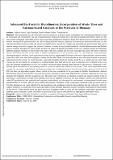Por favor, use este identificador para citar o enlazar a este item:
http://hdl.handle.net/10261/212307COMPARTIR / EXPORTAR:
 SHARE
BASE SHARE
BASE
|
|
| Visualizar otros formatos: MARC | Dublin Core | RDF | ORE | MODS | METS | DIDL | DATACITE | |

| Título: | Advanced bio-fuels for biorefineries: incorporation of waste tires and calcium-based catalysts to the pyrolysis of biomass |
Autor: | Veses Roda, Alberto CSIC ORCID ; Sanahuja-Parejo, Olga CSIC ORCID; Callén Romero, M. Soledad ; García Martínez, Tomás CSIC ORCID | Palabras clave: | Advanced bio-oils Biorefinery Catalytic copyrolisis of biomass and waste tires Lignocellulosic biomass |
Fecha de publicación: | 21-jun-2018 | Editor: | World Academy of Science, Engineering and Technology | Citación: | International Journal of Energy and Power Engineering 12(6): (2018) International Scholarly and Scientific Research & Innovation 12(6): (2018) |
Resumen: | The appropriate use of renewable sources emerges as a decisive point to minimize the environmental impact caused by fossil fuels use. Particularly, the use of lignocellulosic biomass becomes one of the best promising alternatives since it is the only carbon-containing renewable source that can produce bioproducts similar to fossil fuels and it does not compete with food market. Among all the processes that can valorize lignocellulosic biomass, pyrolysis is an attractive alternative because it is the only thermochemical process that can produce a liquid biofuel (bio-oil) in a simple way and solid and gas fractions that can be used as energy sources to support the process. However, in order to incorporate bio-oils in current infrastructures and further process in future biorefineries, their quality needs to be improved. Introducing different low-cost catalysts and/or incorporating different polymer residues to the process are some of the new, simple and low-cost strategies that allow the user to directly obtain advanced bio-oils to be used in future biorefineries in an economic way. In this manner, from previous thermogravimetric analyses, local agricultural wastes such as grape seeds (GS) were selected as lignocellulosic biomass while, waste tires (WT) were selected as polymer residue. On the other hand, CaO was selected as low-cost catalyst based on previous experiences by the group. To reach this aim, a specially-designed fixed bed reactor using N₂ as a carrier gas was used. This reactor has the peculiarity to incorporate a vertical mobile liner that allows the user to introduce the feedstock in the oven once the selected temperature (550 ºC) is reached, ensuring higher heating rates needed for the process. Obtaining a well-defined phase distribution in the resulting bio-oil is crucial to ensure the viability to the process. Thus, once experiments were carried out, not only a well-defined two layers was observed introducing several mixtures (reaching values up to 40 wt.% of WT) but also, an upgraded organic phase, which is the one considered to be processed in further biorefineries. Radical interactions between GS and WT released during the pyrolysis process and dehydration reactions enhanced by CaO can promote the formation of better-quality bio-oils. The latter was reflected in a reduction of water and oxygen content of bio-oil and hence, a substantial increase of its heating value and its stability. Moreover, not only sulphur content was reduced from solely WT pyrolysis but also potential and negative issues related to a strong acidic environment of conventional bio-oils were minimized due to its basic pH and lower total acid numbers. Therefore, acidic compounds obtained in the pyrolysis such as CO₂-like substances can react with the CaO and minimize acidic problems related to lignocellulosic bio-oils. Moreover, this CO₂ capture promotes H₂ production from water gas shift reaction favoring hydrogen-transfer reactions, improving the final quality of the bio-oil. These results show the great potential of grapes seeds to carry out the catalytic co-pyrolysis process with different plastic residues in order to produce a liquid bio-oil that can be considered as a high-quality renewable vector. | Descripción: | Work presented at the ICRRB 2018: International Conference on Renewable Resources and Biorefineries, Toronto, Canada, June 21-22, 2018. | Versión del editor: | https://publications.waset.org/abstracts/78772/pdf | URI: | http://hdl.handle.net/10261/212307 | Identificadores: | e-issn: 1307-6892 url: http://publications.waset.org/abstracts/78772/advanced-bio-fuels-for-biorefineries-incorporation-of-waste-tires-and-calcium-based-catalysts-to-the-pyrolysis-of-biomass |
| Aparece en las colecciones: | (ICB) Artículos |
Ficheros en este ítem:
| Fichero | Descripción | Tamaño | Formato | |
|---|---|---|---|---|
| waset.org_abstracts_78772.pdf | 32,33 kB | Adobe PDF |  Visualizar/Abrir |
CORE Recommender
Page view(s)
196
checked on 19-abr-2024
Download(s)
59
checked on 19-abr-2024
Google ScholarTM
Check
Este item está licenciado bajo una Licencia Creative Commons

